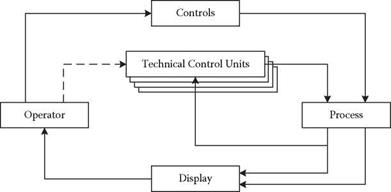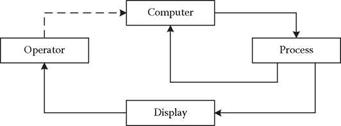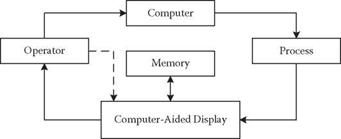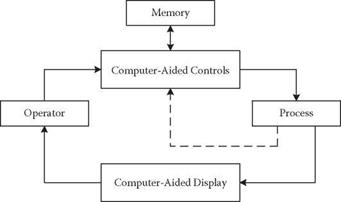It is not difficult to design a model that reflects in a general way how human/machine interaction is usually affected by computerisation as normally carried out in process industries. Moreover, at a general level, the model would not be particularly complicated. The usual reason for working with such a grossly simplified view of human/ machine interaction is that the goals are too limited at the planning stage—being directed mainly towards economic profitability with no deeper understanding of the human role and its contribution to efficiency in such systems. Successively, we have a better understanding about a more meaningful and effective use of the human operator in control rooms. One can see a clear change in focus from operator as a monitor of the process to operators working to optimise the production while at the same time reducing the risk of errors and accidents. Furthermore, the operator has new tasks to redesign and develop the control system and the production process.
The model shown in Figure 2.2 is often used as a basis for discussion of human/ machine systems. This shows, in a simplified way, how the human operator interacts with a process via a display (information device) and a control device. When computerisation takes place, the human operator is replaced by a computerised control system according to Figure 2.2. Figure 2.3 illustrates the principle that the human operator’s primary role becomes that of supervising the process using the computer
|
FIGURE 2.2 Simplified model of the human operator’s role in control systems. |
|
FIGURE 2.3 Simplified model of the human operator’s role in a computerised control system. |
system, and in certain cases (usually when something goes wrong with the automatic control) to intervene and control the system in the traditional way. The dashed line in Figure 2.3 represents the indirect control of the process via the computer; the solid line represents the interaction between the computer control system and the process as it occurs normally.
As a method, Figure 2.3 is a gross simplification. No computer system has yet been installed that completely takes over the majority of the control functions in a process. A process industry consists of a large number of smaller subprocesses, and different subprocesses may have several input and output variables that can sometimes be regulated separately from each other. The various subprocesses, or parts of them, may be automated successively by installing analogue control systems. Initially, these systems of regulators could be sited and controlled locally. As automation proceeds further, the regulators may then be brought together into a common control room for the whole process (remote control). In this way, automation progresses as more and more regulators are brought into service, as shown in Figure 2.4. The operator’s task then becomes one of setting up the set values on the regulators and monitoring the processes that are being controlled automatically. In addition, of course, the nonautomated functions still need to be controlled.
The first stage in computerisation is to start to change the analogue control system to electronic microcomputers. The Honeywell TDC2000 was a first, very early, and typical example where the analogue regulators are replaced by a large number of microcomputers that can then be connected together into a common system (using visual display units [VDUs]) for monitoring and for insertion of the set values via a keyboard. The TDC2000 system has been continuously developed and updated and is still in use. A large number of similar systems are today available for use in, for example, power production, the paper and pulp industry, network supervision, and so forth. A similar system has been developed for information management control (for example, knowledge management).
|
FIGURE 2.4 As automation progresses, the human task becomes one of checking standards and monitoring the automatically controlled process. |
Sometimes, the microcomputer makes possible more advanced control and coordination of the various control loops, for example, sequence regulation and control according to certain programmes. Figure 2.5 shows the case where a number of control functions have been transferred to computer.
This common method of computerisation often resulted in reducing the worker’s active role in the system to such a degree that his or her best characteristics (flexibility, experience, long-term memory, and job skills) are no longer required and the disadvantages of the human as an operator are accentuated (for example, the inability to maintain long-term attention in so-called vigilance situations). Thus the worker’s role and position within the system are not suited to his or her intrinsic abilities. A more recent approach includes the operator in the development of the system. We are slowly seeing a paradigm shift from the ‘rational man’ approach to a more participative way of working.
Human beings could be allowed to remain in the main control circuit but provided with improved information that can be produced by the computer (Figure 2.6). The computers could, for example, be used to take the various readings and to make calculations on the basis of these. One valuable aid may be, for example, to have some form of automatic model of how the process functions. Based on this process model and the different measured values, the computer can calculate (predict) the changes that will occur in the process if there are no further possible control actions
|
FIGURE 2.5 Computer control. |
|
FIGURE 2.6 Computer-aided display. |
as ‘trials’, as shown by the dashed line in Figure 2.5. In this way, one can determine the effects of different control actions on the process. The action that gives the best outcome can thus be found with the aid of the automation and computerisation of information provision.
In a similar way to that shown in Figure 2.7, computers may be used to process and automate the controls used by the workers. In this model the operator is still a part of the control circuit. Traditionally, the steering of a ship is performed by the helmsman, who estimates the angle of the rudder. When steering very large ships, for example, it is very difficult to judge what a particular rudder angle will produce in terms of turning radius of the ship. Based on the desired course, the helmsman sees on the chart or the radar screen not the rudder angle, which should be assumed, but the radius at which the ship should turn. Using this as background, steering aids are being developed today where, instead of giving orders to the steering machinery to set a particular rudder angle, orders are given to a computer on the radius the ship should turn. Knowing the dynamics of the ship, its speed, shape, and the size of the propellers, and so on, the computer chooses a sequence of suitable rudder movements. The computer may also make use of signals giving the turning rate as a type of feedback in order to calculate more reliably the best rudder movement. Thus, the best possible correspondence between the measured and the desired turning radius may be achieved.
These two simplified models for computerisation (Figures 2.6 and 2.7) have a different character from the first (Figure 2.5), which is the most common at present. There have been very few examples of the latter type of computerisation within the process industry. Examples of applications of these forms of computerisation have to be sought in other areas, such as in the control of ships and aircraft, where they can be considerably better in certain connections. This leaves the more interesting and meaningful jobs for the workers, while at the same time they remain at the centre of the process, and their job skills are better used.
|
FIGURE 2.7 Feed forward aid. |









